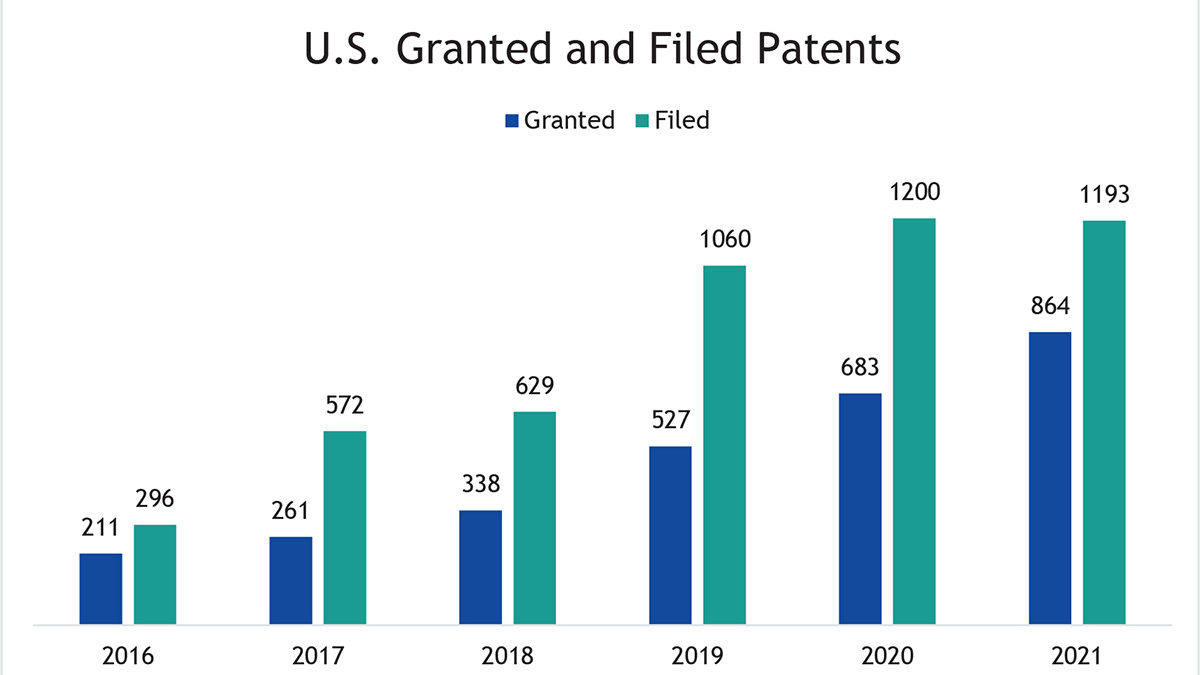Patent Success
Aramco ranks first in oil and gas industry for patents

Global March 30, 2022 - By
From 100 patents granted in 77 years to the top performer in the industry — the story behind our rapid growth in patents.
Over the past 20 years, we strongly invested in innovation as part of our corporate culture to ensure our operations’ long-term sustainability and efficiency. As a result, our patent portfolio has continued to expand.
Up to 2011, we had only been granted 100 U.S. patents over a period of 78 years. Fast forward, in 2021 alone, we were awarded 864 — ranking us first in the oil and gas industry and in the top 50 list of all companies and universities that received U.S. patents in 2021 (based on the Patent 300® List).
This achievement marks an important milestone in Aramco’s quest to become a technology leader. It shows Aramco’s innovation, with approximately 66% of the 864 U.S. patents granted in 2021 originating from new ideas.
While many of the patented solutions are still being developed for our operations and products, we are increasingly helping develop and advance solutions beyond our core business.
The story of our company’s rapid growth of patents underpins our drive to achieve leadership in technology and innovation. That drive has been there from the company’s beginning — and now, the patents inevitably follow as a result of our focus on innovation. Through our growing portfolio of patents, we reinforce our commitment to innovation and to maintain our competitive advantage, helping to drive value and efficiency across all operations.

Why patents matter
Innovation is vital for maintaining a competitive market position in our growing business portfolio and continually improving our performance. Given global challenges and the importance of low carbon economies, innovation and collaboration will need to be accelerated and elevated even further.
While patents are a leading indicator of innovation, the ultimate goal is to create value through the development of solutions that help to address a particular need. Such results are often only possible with significant upfront investments, and patents make it possible to recoup these costs and potentially generate additional revenue through commercialization.
How we drove patent growth
In 2012, we began to expand our research operations outside of our headquarters in Dhahran, Saudi Arabia. We focused on setting up a network of research and technology centers worldwide in proximity to global talent hubs. This boost in research capabilities also accelerated the stream of patents, particularly in high priority areas, such as low carbon solutions and products across multiple key industries.
We have also set up a wide range of co-development programs with leading academic organizations and research institutions, such as the Rice University Carbon Hub in the U.S., Tsinghua University in China1, the Korea Advanced Institute of Science and Technology (KAIST) in South Korea, and Saudi Arabia’s King Abdullah University of Science and Technology (KAUST). These collaborations are focused on potential high-impact solutions across the energy value chain. We help customers and partners address some of their most pressing challenges, particularly those related to carbon management and environmental performance.
Putting patents to work
While many of the patented solutions are still being developed for our operations and products, we are increasingly helping develop and advance solutions beyond our core business. This role and contribution are possible given the company’s deep insights into most areas of the energy value chain, coupled with growing experience with developing leading technology and scaling it. A dedicated team is helping to orchestrate collaboration with partners, getting solutions ready for market introduction, and commercializing patented solutions and industry breakthroughs.
The patents of the future
There is a new emphasis on solutions related to the Fourth Industrial Revolution and its opportunities, such as artificial intelligence and machine learning. These new generation technologies will enable further advancement of our systems and products and their performance, including in the area of low carbon technologies and support of environmental stewardship solutions.
- 1. Source Content Guide 2.0



